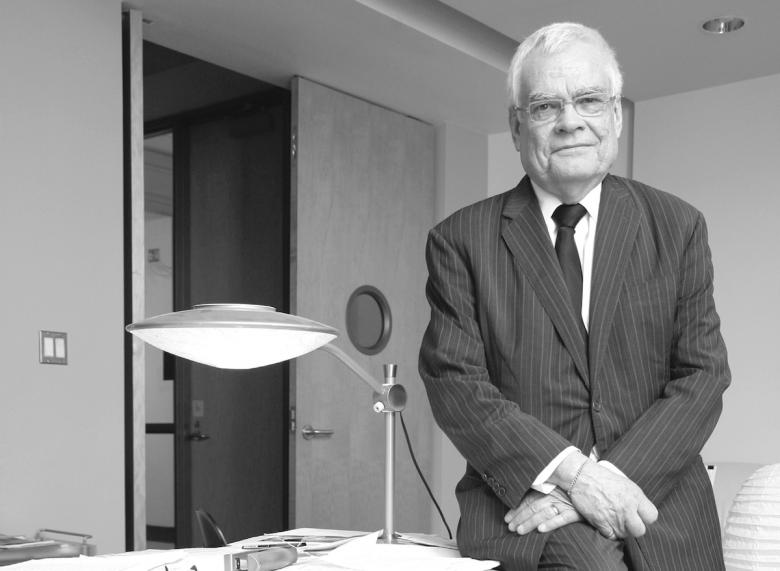George Baird, 1939–2023
John Hill
18. Oktober 2023
Photo of George Baird via University of Toronto John H. Daniels Faculty of Architecture, Landscape, and Design
Canadian architect, educator, and theorist George Baird died in Toronto on October 17, 2023, at the age of 84. His death was announced by the University of Toronto John H. Daniels Faculty of Architecture, Landscape, and Design, where he formerly served as dean.
In the donning of various hats, George Baird had an outsized influence on architecture in and beyond Canada over the last half century. Writing on X yesterday, Harvard professor Charles Waldheim described Baird as “a wonderful teacher, mentor, and role model” and “a singular thinker with a warm and generous sense of humor.” Likewise, a note of Baird's passing on Instagram by Globe and Mail architecture critic Alex Bozikovic elicited comments in admiration of Baird's teaching and his influence on their practices. Coincidentally, a lecture by architect Bruce Kuwabara, a former student and employee of Baird's, is taking place tomorrow at the University of Toronto John H. Daniels Faculty of Architecture, Landscape, and Design, in which he will discuss “the influence of professor emeritus and former Daniels Faculty dean George Baird” on the work of his firm, KPMB Architects.
Born on August 25, 1939, in Toronto, Baird earned his Bachelor of Architecture from the University of Toronto School of Architecture (the Daniels Faculty since 2008) in 1962. He spent the next five years in London, doing postgraduate work at University College London and teaching architectural theory at Royal College of Art and the Architectural Association. In 1972, Baird established George Baird Architects, eventually adding Barry Sampson and Jon Neuert as principals in 1982 and 1998, respectively. Today the firm goes by Baird Sampson Neuert Architects (BSN).
On his return to Toronto from London, Baird started teaching at the University of Toronto, serving as chair of the architecture faculty from 1983 to 1985. After a decade spent at Harvard GSD (1993–2004), Baird returned to U of T in 2004 and served as dean until 2009; his tenure as dean saw the school become the John H. Daniels Faculty of Architecture, Landscape, and Design.
Baird's practice and teaching often overlapped, such that students from U of T often worked in his firm, especially in the early years. George Baird Architects was actually known as a “teaching office,” given how he employed students that are now familiar names, including Bruce Kuwabara, Martin Kohn, Donald MacKay, Detlef Mertins, Thomas Payne, Barry Sampson, Bridgitte Shim, and John van Nostrand.
Over its 50-plus years, BSN has designed and realized many buildings, but it is best known in the areas of urban design and sustainable design. Examples of the first include “Onbuildingdowntown” (1974), the first urban design guidelines for Toronto, and the “Greening Downtown Vancouver” guidelines developed for that city. The firm's innovations in sustainable design are most evident in the 2020 Prix du XXe Siècle Award of Excellence for the Niagara Falls Butterfly Conservatory. The jury for the award given by the Royal Architectural Institute of Canada (RAIC) called the building, completed in 1994, “an enduring and quality example of environmentally sensitive architecture that foreshadowed the sustainability concerns of the 21st century.”
While Baird was influential to architects in Canada through his teachings and practice, his name became familiar outside of the country primarily due to his writings, both in the books he authored and the numerous essays he contributed to journals on architectural criticism and theory. During his time in London he co-edited, with Charles Jencks, Meaning in Architecture (1969), which is considered “one of the first publications in English to introduce what we now know as ‘architectural theory’ to professional and academic audiences in architecture.” His most well-known book is The Space of Appearance, from 1995, in which he attempted to “frame a history of key debates in architectural and urban theory during the twentieth century, within the political theory of [Hannah] Arendt,” particularly in regards to her important 1954 book The Human Condition.
Many of Baird's writings on buildings, architects, urbanism, phenomenology, semiotics, and other subjects or ways of theorizing architecture were collected in the 2015 book Writings on Architecture and the City; five years after that The Architect and the Public: On George Baird’s Contribution to Architecture was published. The latter, with contributions by Peter Eisenman, Kenneth Frampton, K. Michael Hays, Hans Ibelings, Bruce Kuwabara, and more than a dozen others, clearly spells out the influence Baird had on other thinkers, some of which, like Baird, have been able to successfully balance theory and practice, something many architects have a hard time doing.
